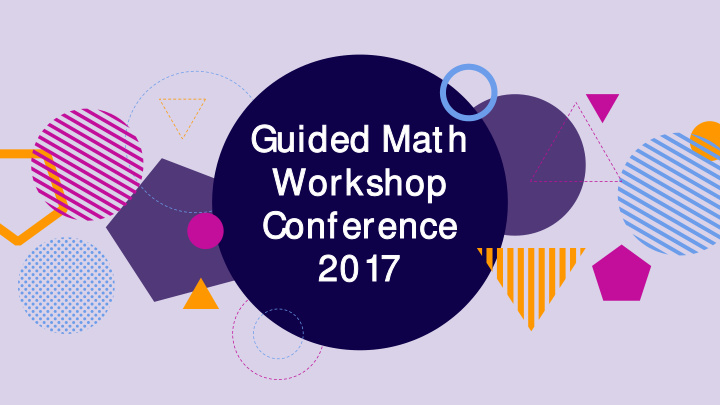



Guide ded M d Math h Wor orkshop op Confer eren ence 2017 17
Guided Math Workshop Structure for Balanced Mathematics Instruction Closure Warm Up ● Summary of the Whole Group ● Number Talks ● Exit Questions ● Number Sense Routines ● Number Sense Routines ● Activate Prior Knowledge Differentiated Small Group Instruction Students are placed in flexible groups based on data Whole Group Mini-Lesson collected from continuous formative assessment ● On Grade Level, Small Group w/ Teacher Leveled Workstations Standards Based Teacher Directed Lessons are for All activities are designed for groups of 3-6 Teacher Directed Individuals and Groups of 3-6 Students at Their Independent Level Instruction ● Students at Their Instructional Level Practice for Current Unit of Study ● On-Topic Practice w/ ● Conferring with Manipulatives Teacher (White Boards!) ● Administering Math ● Problem Solving ● Modeling w/ Running Records ● Strategy Based Fluency Practice Manipulatives ● Interventions ● Place Value ● Modeling Strategies ● Double Dose of Mini- ● Spiral Review ● Modeling Reasoning Lesson ● Vocabulary ● Modeling Problem ● Enrichment & Extensions ● Journals & Mathematical Writing Solving ● Fluency Strategies ● IXL Math, Sumdog, Reflex Online ● Math Language & ● Problem Solving Practice Tools Vocabulary Development
War ar m Up With a a Number T Tal alk What do you see? How are the kittens the same/different? What doesn’t belong? What do you see? How can you write a number Why? How can you write a number sentence for that? How does this relate to sentence for that? fractions? How can this apply to all grades?
Standar ds B s Base sed M Mini L Lesso ssons Using M Manipulatives es f for Concr et ete & e & Visual Rep epr es esentations o of Mathem emat atical C Concep epts ◍ Beaded Number Lines as a Learning Tool: ◌ Kindergarten: Count to 100 by ones and by tens (K.CC.1) ◌ 1st Grade: Understanding place value with tens and ones; Compare two 2-digit numbers (1.NBT.2-3) ◌ 2nd Grade: Extend place value understanding to hundreds; Fluently add and subtract within 100 using strategies; Begin to build an understanding of multiplication using skip counting and repeated addition by 2’s, 5’s, 10’s and 100’s (2.NBT.1,2,5) ◌ 3rd Grade: Rounding; Understanding multiplication and division by creating equal groups (3.NBT.1 & 3.OA.1,2) ◌ 4th Grade: Understanding decimal place value with tenths and hundredths in relation to the fraction; decimal equivalence and comparisons; adding and subtracting decimals in the tenths and hundredths place in relation to the fraction; Division with remainders using equal groups (4.NF.5,6,7 & 4.NBT.6) ◌ 5th Grade: Rounding decimals; Adding and subtracting decimals; Multiplication & division of fractions & decimals using equal groups (5.NBT.4,7)
Col ollect a and U Use Data t to o For or m Gr ou oups Run unning R Recor ds a and F Flue uency G Gr oup ups ◍ Small groups are flexible and are determined by needs/ability of students ◍ Data is collected through frequent/ongoing assessment ◍ Data is used to form groups and inform instruction ◌ Daily observations of students during whole group and small group ◌ Anecdotal notes on students: how work is completed, steps taken, errors made & corrected, journal responses, number talks ◌ Use of individual response boards (whiteboards, Smart Pals) ◌ Student conferences regarding fact fluency using math running records**. ◌ Students’ self-assessment using “thumbs up” routines ◌ Exit slips/Chapter quizzes/unit tests ◌ www.ixl.com diagnostic
Way ays to Or gan anize an and Differ enti tiate te W Wor ksta tati tions ◍ Differentiated Guided Math Workstations ◌ 30-45 minutes of small groups/workstations ◌ Fluency, Word Problems, Vocabulary, Digital, Current Lesson ◌ Rotation Workstations: ◌ More efficient for 3rd and 4th grade ◌ Open-ended tasks (ex: write and illustrate a word problem, open word problems, etc.) ◌ Choice of games, projects and activities (keeps students enjoying stations) ◌ Leveled Activities (modified station for each group. Ex: students play the same game, but with modifications) ◌ Project Workstations: ◌ More efficient for lower grades ◌ Allow students to use math in more creative ways ◌ Free Flow Workstations: ◌ Effective way to give students continued practice with specific skill ◌ Teacher works with each group for 5-15 minutes ◌ Teacher places a variety of activities in tubs according to each groups level/skill Student Data folders → focusing on where they need assistance ◍
Closur e R e Routines es The ex exit t ticket et is simply a question that is posed to all students prior to class ending. ... This formative assessment technique engages all students and provides the all- impo portant nt evidence of student learning for the teacher. The ex exit t ticket et is a great in class assessment tool that can also help plan instruction.
THANK HANK Y YOU!
Recommend
More recommend